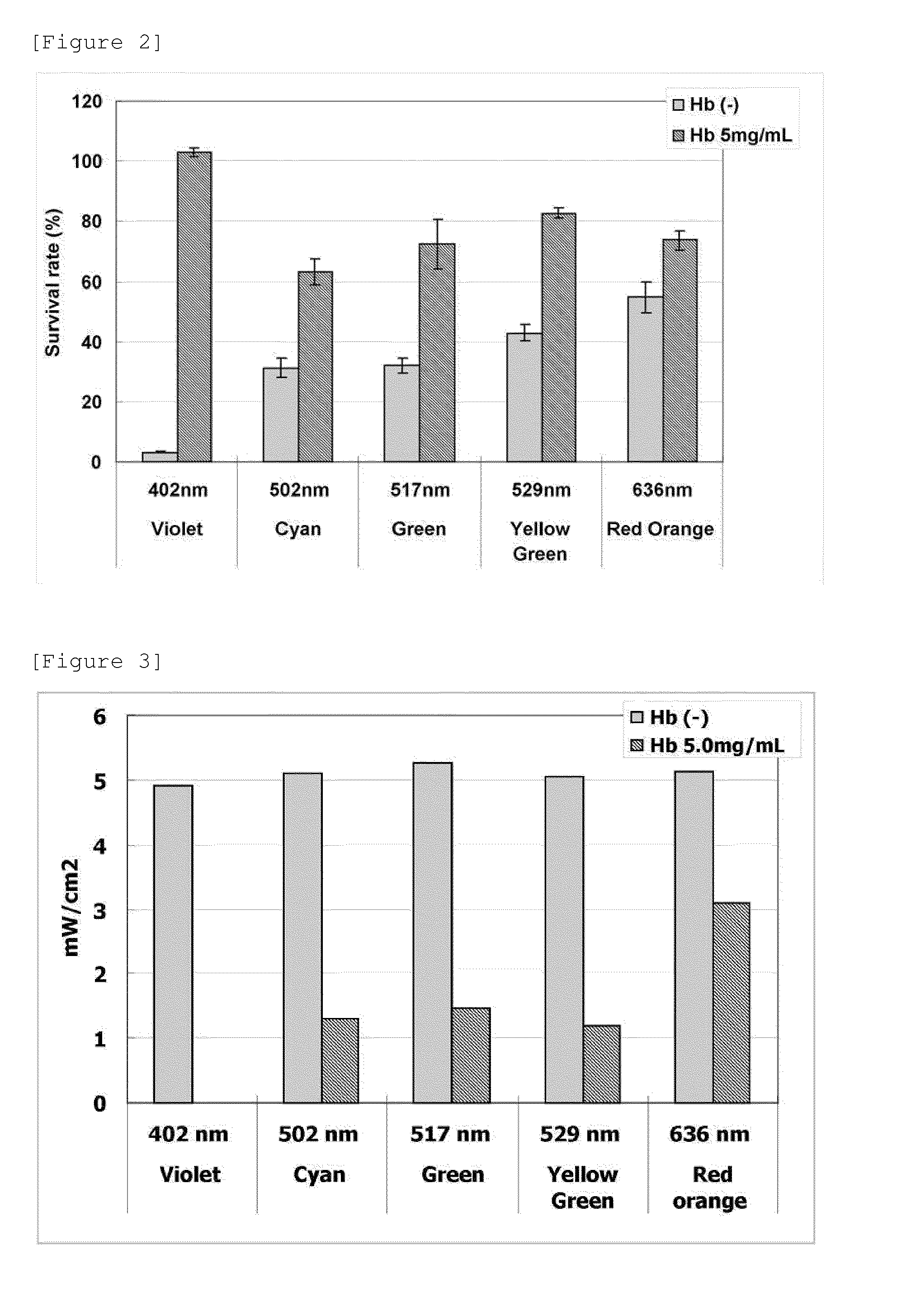Photodynamic therapy using photosensitizing agent or 5-aminolevulinic acid
a technology of photosensitizing agent and photodynamic therapy, which is applied in the field of photodynamic therapy using photosensitizing agent or 5aminolevulinic acid, can solve the problems of difficult diagnosis or treatment of parts requiring a certain degree of deep penetration capability, long light irradiation time for use of light having large optical power density, and low energy and efficiency in excitation of photosensitizing agent, so as to shorten the therapy/diagnosis time, efficien
- Summary
- Abstract
- Description
- Claims
- Application Information
AI Technical Summary
Benefits of technology
Problems solved by technology
Method used
Image
Examples
example 1
(Study of Cell-killing Effect of ALA-PDT Due to Difference in Wavelength)
[0056]MKN45 cells (purchased from Riken Cell Bank) cultured in a 35-mm dish were cultured for 4 hours in the presence of 0.168 mg / mL ALA. Then, 5 mL of a hemoglobin solution was dispensed into a 60-mm dish, placed on the 35-mm dish in which the culture was performed in the presence of ALA, and irradiated with light. Light shielding by hemoglobin was provided to imitate the inside of a living body because hemoglobin is considered to be a leading cause of the inhibition of light invasion in photodynamic therapy. The culture was irradiated to 4.5 J / cm2 (5 mW / cm2, 15 min.) with light having a peak at 402 nm, 502 nm, 517 nm, 529 nm, or 636 nm. As control, without light shielding by hemoglobin, the culture was irradiated by using the same method except for the use of a phosphate buffer solution in place of the hemoglobin solution.
[0057]The survival rate of cells after light irradiation was measured using an MTT assay...
example 2
(Study of Cancer Therapeutic Effect of ALA-PDT Depending on Difference in Wavelength)
[0062]5×105 HeLa cells were subcutaneously injected into SCID mice of the mouse numbers 1 to 3. The size of tumors in the 3 SCID mice into which 5×105 HeLa cells were subcutaneously injected is shown in Table 1 below. Tumors about 4 mm in height were confirmed to be present in the mouse subcutis. After maintaining the mice until the size of tumors reaches that described in Table 1, 750 mg / kg b.w. of ALA was injected into the tail vein of the mice of numbers 1 and 2. After 4 hours, the mouse of number 1 was irradiated with LED light having a peak at a wavelength of 517 nm and the mouse of number 2 was irradiated with LED light having a peak at a wavelength of 629 nm.
TABLE 1Irradiation LightTumor Size (mm)(100 J / cm2 each)MouseMajorMinor517 nm629 nmNo.ALADiameterDiameterHeight(Green)(Red)1(+)13.010.03.7(+)(−)2(+)10.39.04.1(−)(+)3(−)12.09.14.6(−)(−)
[0063]The SCID mice irradiated with light listed above ...
PUM
| Property | Measurement | Unit |
|---|---|---|
| wavelength | aaaaa | aaaaa |
| wavelength | aaaaa | aaaaa |
| wavelengths | aaaaa | aaaaa |
Abstract
Description
Claims
Application Information
 Login to View More
Login to View More - R&D
- Intellectual Property
- Life Sciences
- Materials
- Tech Scout
- Unparalleled Data Quality
- Higher Quality Content
- 60% Fewer Hallucinations
Browse by: Latest US Patents, China's latest patents, Technical Efficacy Thesaurus, Application Domain, Technology Topic, Popular Technical Reports.
© 2025 PatSnap. All rights reserved.Legal|Privacy policy|Modern Slavery Act Transparency Statement|Sitemap|About US| Contact US: help@patsnap.com



